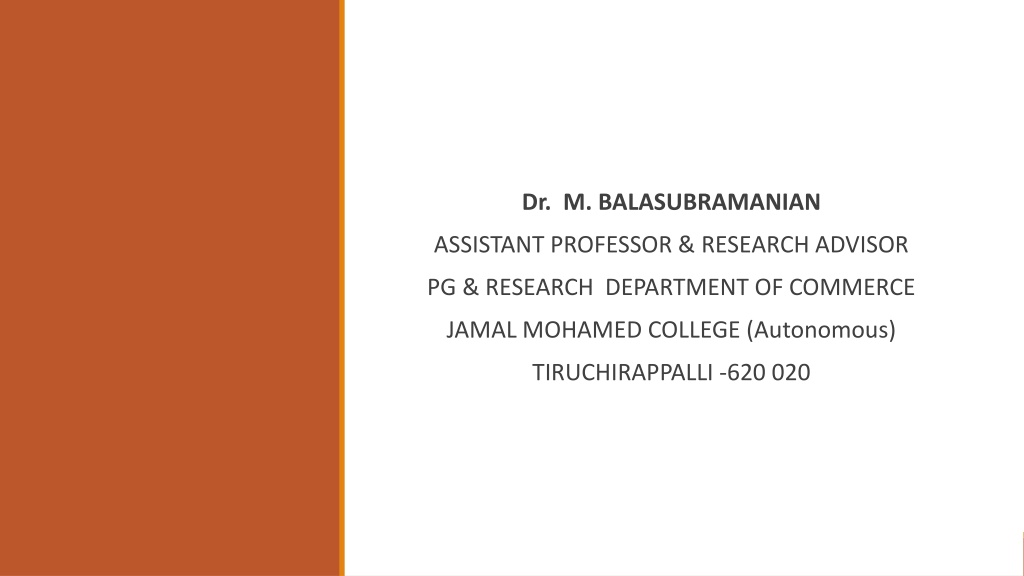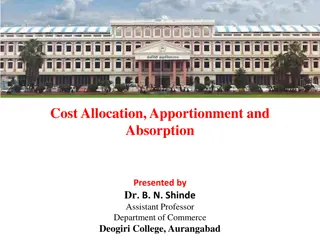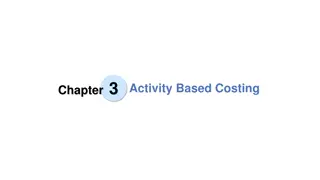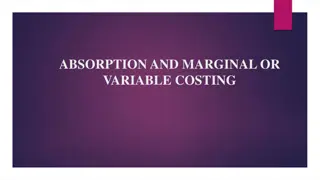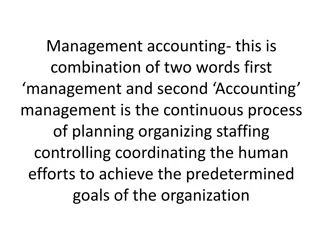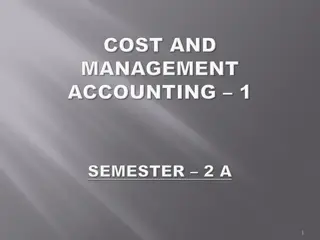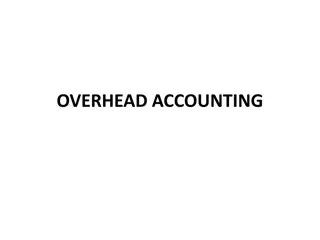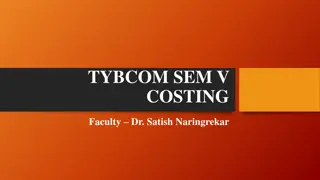Understanding Overheads in Cost Accounting
Overheads in cost accounting refer to business costs not directly tied to specific activities or units. They play a crucial role in pricing products and services to ensure profitability. Overheads are classified based on elements, behavior, function, control, and nature. This classification helps in better management and control of overhead costs within an organization.
Download Presentation

Please find below an Image/Link to download the presentation.
The content on the website is provided AS IS for your information and personal use only. It may not be sold, licensed, or shared on other websites without obtaining consent from the author. Download presentation by click this link. If you encounter any issues during the download, it is possible that the publisher has removed the file from their server.
E N D
Presentation Transcript
Dr. M. BALASUBRAMANIAN ASSISTANT PROFESSOR & RESEARCH ADVISOR PG & RESEARCH DEPARTMENT OF COMMERCE JAMAL MOHAMED COLLEGE (Autonomous) TIRUCHIRAPPALLI -620 020
COST ACCOUNTING Topic: Overheads
OVERHEADS Introduction Classification of overheads refers to the process of grouping costs according to their common characteristics. The overhead costs are incurred not for any job, work-order, process or unit but for the business as a whole and include all costs other than direct material costs, direct wages and direct expenses. Overhead costs are also denoted by supplementary costs non- productive costs , indirect costs , on cost , burden etc. Of all the terms, overhead is the most common and the Institute of Cost and Management Accountants, London, does not recommend the use of the terms on cost and burden .
Overheads are business costs that are related to the day-to-day running of the business. Unlike operating expenses, overheads cannot be traced to a specific cost unit or business activity. Instead, they support the overall revenue-generating activities of the business. Overhead costs are important in determining how much a company must charge for its products or services to generate a profit. Expenses can be divided into several different types, including equipment costs, inventory, and facilities costs. These business expenses can be further divided into overhead or operating costs, each of which depends on the nature of the business being run. Operating expenses are the result of a business's normal operations, such as materials, labour, and machinery involved in production. Overhead expenses are what it costs to run the business, including rent, insurance, and utilities.
Classification means determination of categories, classes or groups in which overhead costs may be subdivided. CIMA has defined classification as the arrangement of items in logical groups having regard to their nature (subjective classification) or the purpose to be fulfilled (objective classification) . The overheads can be classified under the following heads:- 1. Element 2. Behaviour 3. Function 4. Control 5. Nature 7. Selling and Distribution 8. Office 9. Production. Element wise classification of overheads includes:- 1. Indirect Materials 2. Indirect Labour 3. Indirect Expenses. Behaviour wise classification of overheads includes:- 1. Fixed Overheads 2. Variable Overheads 3. Semi-Variable or Semi-Fixed Overheads 4. Step Overheads Function wise classification of overheads includes:- 1. Factory Overheads 2. Administration Overheads 3. Selling Overheads 4. Distribution Overheads 5. Manufacturing Overheads 6. Research and Development Overheads.
Control wise classification of overheads includes:- 1. Controllable Overheads 2. Uncontrollable Overheads. Nature wise classification of overheads includes:- 1. Normal Overheads 2. Abnormal Overheads.
Types of Overheads 1. Fixed overheads: Fixed overheads are costs that remain constant every month and do not change with changes in business activity levels. Examples of fixed overheads include salaries, rent, property taxes, depreciation of assets, and government licenses. 2. Variable overheads: Variable overheads are expenses that vary with business activity levels, and they can increase or decrease with different levels of business activity. During high levels of business activity, the expenses will increase, but with reduced business activities, the overheads will substantially decline or even be eliminated. Examples of variable overheads include shipping costs, office supplies, advertising and marketing costs, consultancy service charges, legal expenses, as well as maintenance and repair of equipment. 3. Semi-variable overheads: Semi-variable overheads possess some of the characteristics of both fixed and variable costs. A business may incur such costs at any time, even though the exact cost will fluctuate depending on the business activity level. A semi-variable overhead may come with a base rate that the company must pay at any activity level, plus a variable cost that is determined by the level of usage. Examples of semi-variable overheads include sales commissions, vehicle usage, and some utilities such as power and water costs that have a fixed charge plus an additional cost based on the usage.
Examples of Overhead Costs Overhead costs are important in determining how much a company must charge for its products or services in order to generate a profit. The most common overhead costs that any business incur include: 1. Rent: Rent is the cost that a business pays for using its business premises. If the property is purchased, then the business will book depreciation expense. Rent is payable monthly, quarterly, or annually, as agreed in the tenant agreement with the landlord. When the business is experiencing slow sales, it can reduce this cost by negotiating the rental charges or by moving to less expensive premises. 2. Administrative costs: Administrative costs are costs related to the normal running of the business and may include costs incurred in paying salaries to a receptionist, accountant, cleaner, etc. Such costs are treated as overhead costs since they are not directly tied to a particular function of the business and they do not directly result in profit generation. Rather, administrative costs support the general running of the business. Examples of administrative costs may include audit fees, legal fees, employee salaries, and entertainment costs. A business can reduce administrative expenses by laying off some of its employees, switching employees from full-time to part-time, hiring employees on a contract basis, or by eliminating certain expenses, such as entertainment and office supplies.
3. Utilities: Utilities are the basic services that the business requires to support its main functions. Examples of utilities include water, gas, electricity, internet, sewer, and phone service. A business may be able to reduce utility expenses by negotiating for lower rates from suppliers. 4. Insurance: Insurance is a cost incurred by a business to protect itself from financial loss. There are various types of insurance coverage, depending on the risk that may cause loss to the business. For example, a business may purchase property insurance to protect its property or business premises from certain risks such as flood, damage, or theft. Another type of insurance is professional liability insurance that protects the business (such as an accounting firm or law firm) from liability arising from malpractice. Other types of insurance include health insurance, home insurance, renter s insurance, flood insurance, life insurance, disability insurance, etc. Another type of insurance is professional liability insurance that protects the business (such as an accounting firm or law firm) from liability arising from malpractice. Other types of insurance include health insurance, home insurance, renter s insurance, flood insurance, life insurance, disability insurance, etc.
5. Sales and marketing: Sales and marketing overheads are costs incurred in the marketing of a company s products or services to potential customers. Examples of sales and marketing overheads include promotional materials, trade shows, paid advertisements, wages of salespeople, and commissions for sales staff. The activities are geared toward making the company s products and services popular among customers and to compete with similar products in the market. 6. Repair and maintenance of motor vehicles and machinery:Rent and maintenance overheads are incurred in businesses that rely on motor vehicles and equipment in their normal functions. Such businesses include distributors, parcel delivery services, landscaping, transport services, and equipment leasing. Motor vehicles and machinery need to be maintained on a continuous basis and repaired whenever they break down.
Apportionment of Overhead The overheads, which can be easily shared by the two or more departments on suitable basis, are called apportionment. The basis is determined according to the extent of services derived by the departments or benefits available to the department. According to ICMA, London, apportionment of expenses means, the allotment to two or more departments or cost centres of proportions of common items of cost on estimated basis of benefit received . Cost Allocation When items of cost are identifiable directly with some products or departments such costs are charged to cost centres. This process is known as cost allocation. It is the charging of discrete, identifiable items of cost to cost centres or cost units. It is complete distribution of an item of overhead to the departments or products on logical or equitable basis is called allocation. Where a cost can be clearly identified with a cost centre or cost unit, then it can be allocated to that cost centre or unit.
Allocation is the process by which cost items are charged directly to a cost unit or cost centre. Cost allocation calls for two basic factors Concerned department/product should have caused the cost to be incurred Exact amount of cost should be computable Cost Allocation- Examples Electricity charges can be allocated to various departments if separate meters are installed Depreciation of machinery can be allocated to various departments as the machines can be identified Salary of stores clerk can be allocated to stores department Cost of coal used in boiler can be directly allocated to boiler house division. Wages paid to workers of service department can be allocated to the particular department. Indirect materials used by a particular department can also be allocated to the department.
Cost Apportionment Cost Apportionment is the allotment of proportions of items to cost centres. When items of cost cannot directly charge to or accurately identifiable with any cost centres, they are prorated or distributed amongst the cost centres on some predetermined basis. This method is known as cost apportionment. Wherever possible, the overheads are to be allocated. However, if it is not possible to charge the overheads to a particular cost centre or cost unit, they are to be apportioned to various departments on some suitable basis. This process is called as Apportionment of overheads. Items of indirect costs residual to the process of cost allocation are covered by cost apportionment. The predetermination of suitable basis of apportionment is very important and usually following principles are adopted- (i) Service or use (ii) Survey method (iii) Ability to bear.
Distinction between Allocation & Apportionment Although the purpose of both allocation and apportionment is identical, i.e to identify or allot the costs to the cost centres or cost unit, both are not the same. Allocation deals with the whole items of cost and apportionment deals with proportion of items of cost. Allocation is direct process of departmentalization of overheads, whereas apportionment needs a suitable basis for sub-division of the cost. Whether a particular item of expense can be allocated or apportioned does not depends on the nature of expense but depends on the relation with the cost centre or cost unit to which it is to be charged.
Basis for Overhead Apportionment Basis for Overhead Apportionment Overheads common to all these departments Apportioned on some suitable basis Rent, rates & taxes Floor space occupied by each department , office, factory Repair to Plant or Department, Plant or Department's Value or any asset's Depreciation on office building Floor space occupied by each department For Legal fees No of cases handled as the basis For Salaries of common staff Ratio of salaries of departments as the basis For Typist pool No of documents typed as the basis For General Lighting and electricity No. of light points or Area or Units of Sub-meter in each Department For Telephones No. of extensions in a department For Material handling No. of material requisitions or Value of material issued Power H.P. Of Plant Supervision, Employer's liability No. of Employees Value of Stock in any Department Fire Insurance Indirect Labour Cost Total duty hours in any department Canteen Service Cost and other welfare expenses No. of Employees in Any Department Transport Cost No. of boxes or containers or weight of containers, hours of spending vehicle in any department
Under-absorption and Overabsorption of Overhead Certain expenses may be direct expenses for certain costs centres, but they are indirect for the production departments. These do not form part of prime cost but absorbed as overheads. The amount of overhead absorbed in costs is the sum total of the overhead costs allotted to individual cost units by application of the overhead rate. Note: When a predetermined rate worked out based on anticipated or budgeted overhead and base is applied to the actual base, the amount absorbed may not be identical with the amount of overhead expenses incurred if either the actual base or the actual expenses or both deviate from the estimates or the budget. Under-absorption and Overabsorption of Overhead Under-absorption If the amount absorbed is less than the amount incurred , the difference denotes under absorption. It is also termed as 'under recovery' It may be due to Actual expenses exceeding the estimate; and / or Output or the hours worked may be less than the estimate.
Over-absorption If the amount absorbed is more than the expenditure incurred this would indicate over- absorption, which goes to inflate the costs. Over-absorption is also formed as 'over recovery'. It may be due to Expense being less than estimate; and / or Output or hours worked may be exceeding the estimate. Under Costing and Over Costing Product under Absorption: A product consumes a high level of resources but is reported to have a low cost per unit (Joe s Dinner) Product Over Absorption: A product consumes a low level of resources but is reported to have a high cost per unit (Annie s Dinner)
Causes of Under or Over Absorption of Overhead Example: if the overheads absorbed on a predetermined basis are Rs: 1, 00,000 But the actual overheads incurred are Rs. 1, 20,000, There is under-absorption to the extent of Rs.20, 000. Example: If the overhead rate is predetermined to be Rs.20 per direct labour hour consumed But the actual amount should have been Rs.18 per hour Then the $2 difference is considered to be over absorbed overhead.
What are the strategic consequences of product under costing and over costing? Under costed products Under-priced-increasing demand-lowering profits (losses) Overpricing products lose market share to competitors producing similar products Product over-costing and under-costing leads to managerial attention to wrong products Allocation and apportionment of overheads and then absorption of overheads helps for finding total cost of production for better decision making for cost control and cost reduction.
